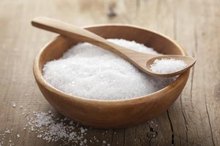Can You Lower Sodium With Yogurt?
Although many dairy products are limited on a low-sodium diet, yogurt is encouraged because of its naturally low sodium levels and high potassium levels 1. The potassium in yogurt might actually help flush excess sodium from your body. Yogurt is a source of probiotics, beneficial bacteria that can repopulate your digestive tract to aid in digestion and boost your immune system. An easy food to eat on-the-go, yogurt is a low-calorie, high-protein source of calcium and vitamin D.
Eat two servings of low-fat, low-sodium yogurt daily. One of the key reasons to lower your sodium intake is to lower your blood pressure level, reducing your risk of heart disease. According to the U.S. Food and Drug Administration, potassium-rich foods "blunt the effects of salt on blood pressure" and may also help prevent kidney stones, which can occur if you have too much calcium. Although you can get potassium from supplements, your body absorbs it best from whole foods such as yogurt.
What Is the Healthiest Yogurt to Eat?
Learn More
Substitute low-sodium yogurt for high-sodium dairy products such as buttermilk and cottage cheese 1. Yogurt is creamy and has a slightly sour taste, making it a useful substitute for buttermilk in baking recipes. Yogurt with fruit or granola is lower in sodium and a better snack choice than cottage cheese and fruit.
Read the nutritional label on yogurt. Not all yogurts are created equal -- many have added sugars or flavors that can increase the sodium content. If you like fruit in your yogurt, buy plain yogurt and add your own fresh fruit.
Tips
The American Heart Association recommends limiting sodium intake to 1,500 mg daily. One cup of plain, low-fat yogurt contains less than 200 mg of sodium.
Warnings
Not all dairy products are low in sodium. Natural cheese, processed cheese and cheese spreads can be very high in sodium.
Related Articles
References
- U.S. Department of Agriculture: Dietary Guidelines for Americans 2005 -- Sodium and Potassium
- American Heart Association: 2010 Dietary Guidelines
- Fernandez MA, Marette A. Potential Health Benefits of Combining Yogurt and Fruits Based on Their Probiotic and Prebiotic Properties. Adv Nutr. 2017;8(1):155S-164S. doi:10.3945/an.115.011114
- U.S. Department of Agriculture. FoodData Central. Yogurt, plain, whole milk.
- Astrup A, Geiker NRW, Magkos F. Effects of full-fat and fermented dairy products on cardiometabolic disease: Food is more than the sum of its parts. Adv Nutr. 2019;10(5):924S-930S. doi:10.1093/advances/nmz069
- Westerterp-plantenga MS, Lemmens SG, Westerterp KR. Dietary protein - its role in satiety, energetics, weight loss and health. Br J Nutr. 2012;108 Suppl 2:S105-12. doi:10.1017/S0007114512002589
- U.S. Department of Agriculture. FoodData Central. Yogurt, Greek, plain, low fat.
Tips
- The American Heart Association recommends limiting sodium intake to 1,500 mg daily. One cup of plain, low-fat yogurt contains less than 200 mg of sodium.
Warnings
- Not all dairy products are low in sodium. Natural cheese, processed cheese and cheese spreads can be very high in sodium.
Writer Bio
Maura Shenker is a certified holistic nutritionist and health counselor who started her writing career in 2010. She leads group workshops, counsels individual clients and blogs about diet and lifestyle choices. She holds a Bachelor of Fine Arts from the Rhode Island School of Design, a Master of Fine Arts from The Ohio State University and is a graduate of the Institute for Integrative Nutrition.









